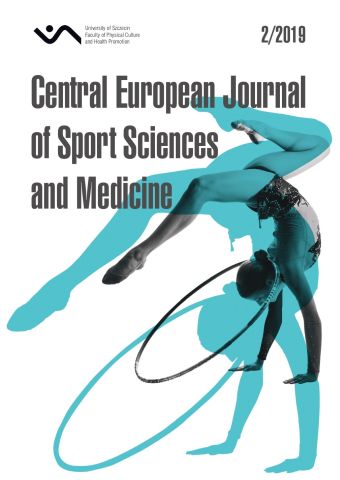
ISSN: 2300-9705
eISSN: 2353-2807
OAI
DOI: 10.18276/cej.2019.2-03




Lista wydań /
Vol. 26, No. 2/2019
The Effect of Corrective Exercises on the Range of Motion of the Hip Joints and the Result Obtained in the Deep Squat of FMS Test
| Autorzy: |
Jolanta
Oleksiak
Department of Heart Failure and Cardiac Rehabilitation of the Warsaw Medical University Anna Sobianek Department of Physical Education and Sport of the Warsaw Medical University Maciej Janiszewski 
Department of Heart Failure and Cardiac Rehabilitation of the Warsaw Medical University |
| Słowa kluczowe: | squat mobility range of motion foam rolling stretching |
| Data publikacji całości: | 2019-06-31 |
| Liczba stron: | 10 (31-40) |
Abstrakt
Squat is a fundamental motor pattern in everyday activities, e.g. sitting or lifting objects from the ground. One of the reasons for the poor quality of the squat pattern lies in limited mobility. The study assessed the effects of one-off and 4-week squat correction based on the mobility system exercises. The study involved 40 people, divided into a test group (18 women, 2 men, ± 24.6 years) and a control group (10 women, 10 men ± 23.6 years). All participants have been subjected to three tests twice: a deep squat test - according to the FMS ™ concept, the Active Straight Leg Raise test and the "four" test. After the test, four corrective exercises were recommended and the study continued. The subjects from the test group performed the recommended exercises for 4 weeks, 3 times a week. The protocol was repeated for both groups after 4 weeks, according to the same methodology. For the ASLR test and the "four" test, a significant improvement was observed both after a single session and after a 4-week correction program. With the improvement of these ranges, the result in the deep squat test also improved. A statistically significant improvement in the result was obtained in 9 out of 40 people (22.5%) after a single measurement. As a result of a 4-week correction, the improvement of the squat occurred only after repeated correction. The use of corrective exercises in the hip joints may translate into an improvement in the squat pattern.
Pobierz plik
Plik artykułu
Bibliografia
| 1. | Aptowicz J. (2010) Zastosowanie FMS. (Functional Movement Screen) do oceny ruchomości funkcjonalnej na przykładzie zawodników uprawiających taekwondo olimpijskie. Olsztyńska Szkoła Wyższa im. Józefa Rusieckiego, Olsztyn.Tom 10 (4). |
| 2. | Avala F., Sainz De Baranda P., De Ste Croix M. (2010) Effect of active stretch on hip flexion range of motion in female professional futsal players. J Sports Med Phys Fitness, 50(4):428-35. |
| 3. | Bradbury-Squires D.J., Noftall J.C., Sullivan K.M., Behm D.G., Power K.E., Button D.C. (2015) Roller-massager application to the quadriceps and knee-joint range of motion and neuromuscular efficiency during a lunge. J Athl Train, 50(2):133-140. |
| 4. | Couture G. (2015) The Effect of Foam Rolling Duration on Hamstring Range of Motion. The Open Orthopaedics Journal, 9: 450-455. |
| 5. | Davis D.S., Ashby P.E., McCale K.L., McQuain J.A., Wine J.M. (2005) The effectiveness of 3 stretching techniques on hamstring flexibility using consistent stretching parameters. J Strength Cond Res, 19(1): 27–32. |
| 6. | Hara D., Nakashima Y., Hamai S., Higaki H., Ikebe S., Shimoto T., Yoshimoto K., Iwamoto Y. (2016) Dynamic hip kinematics in patients with hip osteoarthritis during weight-bearing activities. Clin Biomech (Bristol, Avon), 32:150-6. |
| 7. | Jay K., Sundstrup E., Sondergaard S.D., Behm D., Brandt M., Saervoll C.A., Jakobsen M.D., Andersen L.L. (2014) Specific and cross over effects of massage for muscle soreness: randomized controlled trial. International Journal of Sports Physical Therapy, 9:82–9. |
| 8. | Kistler B.M., Walsh M.S., Horn T.S., Cox R.H. (2010) The acute effects of static stretching on the sprint performance of collegiate men in the 60- and 100-m dash after a dynamic warm-up. J Strength Cond Res, 24(9):2280–2284. |
| 9. | Macdonald G.Z., Button D.C., Drinkwater E.J., Behm D.G. (2014) Foam Rolling as a Recovery Tool after an Intense Bout of Physical Activity. Medicine & Science in Sports & Exercise, 46(1):131-42. |
| 10. | Mankin H.J., Treadwell B.V. (1986) Osteoartritis: a 1987 update. Bull Rheum Dis, 36(5):1-10. |
| 11. | Marciniak J. (1998): Zbiór ćwiczeń koordynacyjnych i gibkościowych. Centralny Ośrodek Sportu, Warszawa. |
| 12. | Monteiro E.R., Škarabot J., Vigotsky A.D. (2017) Acute effects of different self-massage volumes on the FMS™ overhead deep squat performance. Int J Sports Phys Ther, 12(1):94-104. |
| 13. | O'Sullivan K., Murray E., Sainsbury D. (2009) The effect of warm-up, static stretching and dynamic stretching on hamstring flexibility in previously injured subjects. BMC Musculoskelet Disord, 10:37. |
| 14. | Rurak P. Gibkość, ruchomość i mobilność. (2013) Retrieved from: http://paulpipers.pl/blog/2013/11/gibkosc-ruchomosc-i-mobilnosc/; date of acces: 15.03.2017 |
| 15. | Sullivan K.M., Silvey D.B.J., Button D.C., Behm D.G. (2013) Roller-massager application to the hamstrings increases sit-and-reach range of motion within five to ten seconds without performance impairments. Int J Sports Phys Ther, 8(3):228-236 |
| 16. | Trener Indywidualny. Przysiad – ćwiczenie fundamentalne. Retrieved from: http://www.trenerindywidualny.pl/2014-05-05-12-58-36/artykuly-trening-silowy/1636-przysiad-cwiczenie-fundamentalne.html; date of acces: 27.02.2017 |